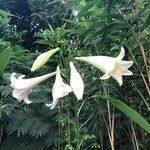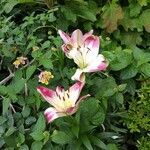A bulb or lily plant. It grows 90-100 cm high and spreads 30-45 cm wide. The leaves are scattered and shiny. They are 18 cm long. The flowers are horizontal and trumpet shaped. They have a strong smell. They are 18 cm long and white with a green stripe in the centre.


